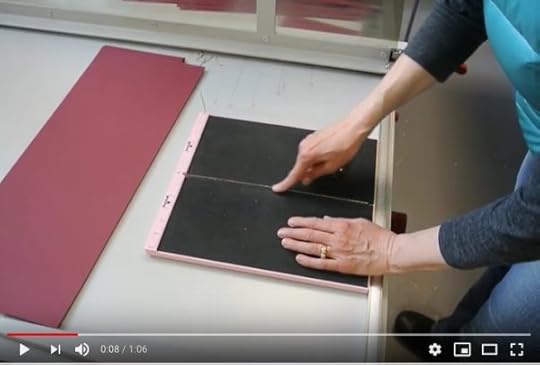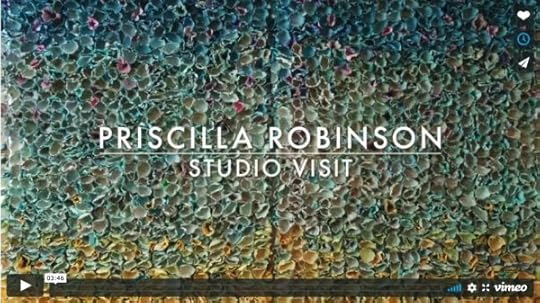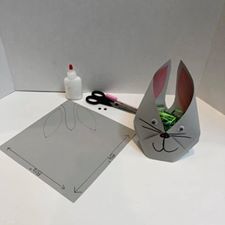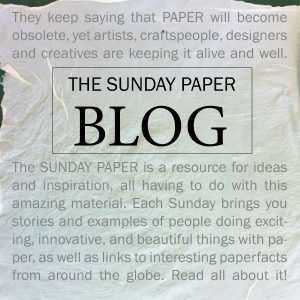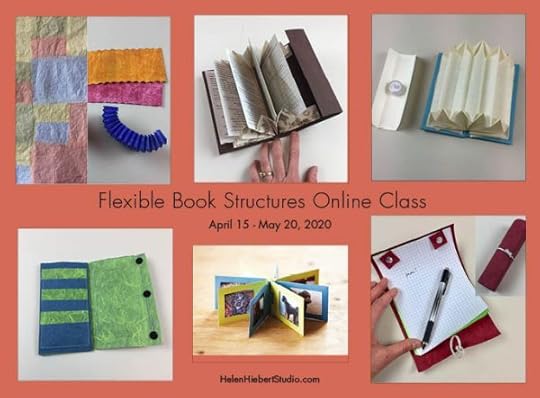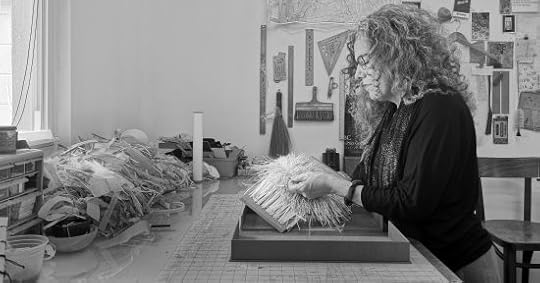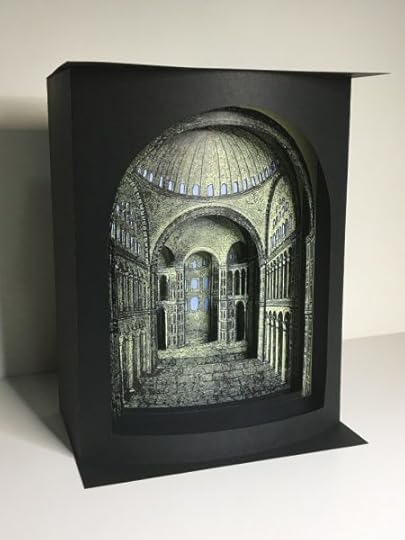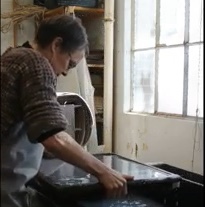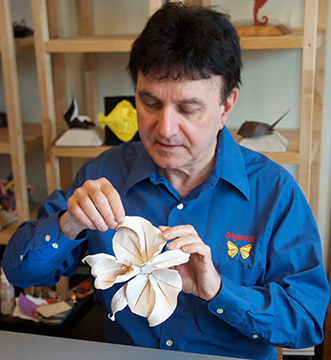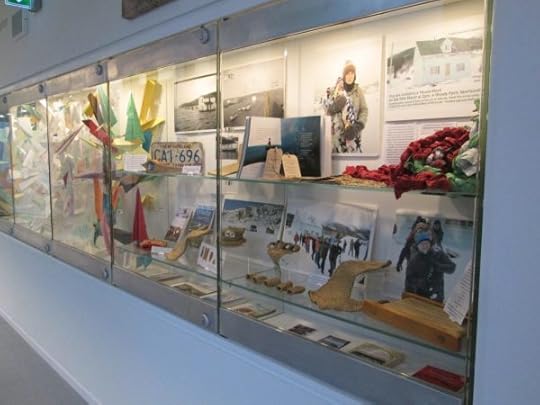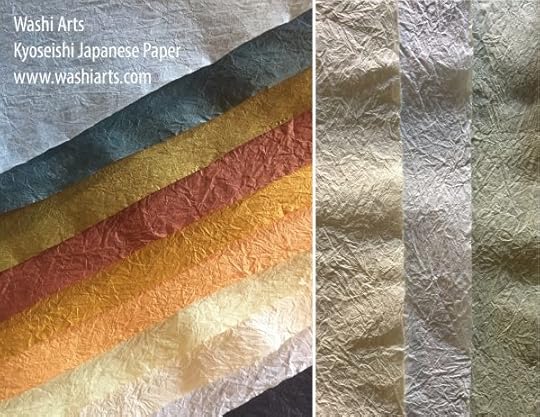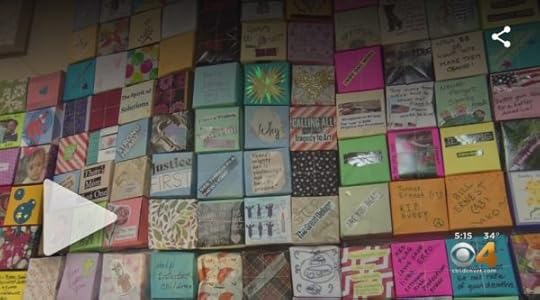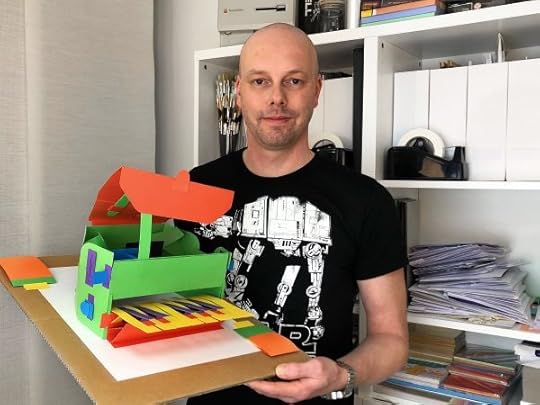Helen Hiebert's Blog, page 30
March 28, 2020
Snail Mail
The Sunday Paper #305
March 29, 2020
Paper of the Week: See Through Assortment

Times, they are a changing! I’ll be listing a few sets of paper each week until business gets back to normal, or a new normal. Limited quantities of this See Through Assortment are available on my website in The Paper Shop. Thanks to those of you who made purchases last week!
———————————————————————————————–––––––
In the Studio:
I made this short video showing how I set up a scoring jig to streamline the process of scoring 50 sheets of paper. Necessity is the mother of invention!
———————————————————————————————–––––––
Papery Tidbits:
I’m going to be one of several guest artists on Alyson Stanfield’s Teaching Art Online Summit this Wednesday, April 1st. This is for artists considering teaching classes or mentoring online, and it is running on the “pay what it’s worth model” (new to me, pretty cool idea).
Earlybird pricing for Flexible Book Structures ends April 1st (no fooling)! Join us and learn to make six book structures in this online class, which begins on April 15th.
Need a project for the kiddos (or yourself)? Here’s a Spring Shamrock video tutorial, which could double as a snowflake (it is still snowing here in Colorado). This can be made from any paper. Send me a photo if you try it!
———————————————————————————————–––––––
When I was in Japan last fall, I had the opportunity to meet up with Richard Flavin in Tokyo and interviewed him on Paper Talk. I’m sorry our recording isn’t the best, but I hope you’ll have a listen. You might be familiar with Richard’s illustrations of Japanese papermaking in Tim Barrett’s book of the same title. Richard grew up in Boston, and he learned about woodblock printing and handmade paper when he was in the army in Korea and traveled to Japan, where he has lived and worked since 1970. We met to talk about his work with paper in the gallery that he and his textile artist wife Ryoko Haraguchi, run. I didn’t get to visit his papermaking studio (Jionji Press) in Saitama Prefecture, but you’ll find pictures of his papered floors and kitchen cabinets in the show notes. Enjoy our conversation!
Snail mail to the rescue! Chandler O’leary is an amazing illustrator, artist, wordsmith and all around great gal. Greetings from the Best Coast, a companion book of postcards to her popular Best Coast book was just released this week, and she had in person book signings scheduled for this weekend. Well, as you can imagine, Chandler is at home instead, but we can still support her by making purchases via her online shop! This set of 32 postcards (2 each of 16 designs) is perfect-bound in a hard cover (and it is just $15).
As Chandler says, we are all armchair travelers now. You can also get an autographed copy of Chandler’s book, The Best Coast, an illustrated travel guide that celebrates the West Coast’s historic highways (I snapped one up when it came out last year). Chock-full of unusual facts, hidden history, and Americana (not to mention Chandler’s illustrations!), The Best Coast is an offbeat road trip guide that tells the story of the diversity and depth that created the West Coast we know and love today.
I’m going to be promoting artists as I can here on the blog to help them replace some of their income during the pandemic. Please reach out if you have a paper product to sell (or a paper tutorial to share) that you think my readers might enjoy.
This is kind of fun. A few years ago, I did a quick video tour of Priscilla Robinson’s studio when I was in Austin, TX. Check out this video that her gallery, Wally Workman, created. They mixed in additional still images of Priscilla’s work to create a new video.
Jade Quek writes a fantastic round-up of paper and book-related goings-on. Here’s a link to her online calendar, and you can also sign up to get her monthly e-mail: jsqcentral-workshop@yahoo.com.
———————————————————————————————–––––––
The News from Here:
Colorado finally received shelter in place orders on Wednesday. • I know someone personally who has COVID-19 here in town (he is in the hospital) and have heard about someone in another state who presumably had it and recovered (he was not tested). • Sadly, two people, from my community of 50,000, have died (one was a man in his 40’s, the youngest to die in the state, a father of three). • My husband’s company reduced his (and most of the company’s) hours and salary by 40%. • Ted reads everything he can about the virus (I cannot bring myself to do this, but I absorb plenty), and he has purchased plastic to quarantine our loft, in case one of us gets sick. • This is sobering.
On the bright side, as people try to stay in business online, our grocery stores are offering online ordering and curbside pickup (heck, maybe they offered this already); my health club is starting an online Virtual Gym; we are getting out when we can to help others by delivering food and loading trucks through The Salvation Army; I am still questioning the movement to make face masks (are they safe? will they work? will they get to the right place? but I am thankful for the energy some of you are putting into this!! Paul DeGraaf (find him on FB) has designed a one-sheet paper face mask that is going viral. Who knows? Maybe paper will save the day! And my goodness, our health care workers and those who work in essential jobs are my heroes (I enjoyed this interview with a sanitation worker in the Bay Area titled “Showing up for Work During a Global Pandemic.”
Please be careful and take care of yourself. Help out where you can, and know that I appreciate you!
———————————————————————————————–––––––
And a treat! I posted a challenge to members of The Paper Studio, to create something from a square of paper. Look at this adorable Easter basket that Lore Spivey made. And you can see how to make your own in the photo!
———————————————————————————————–––––––
Featured this week in my Studio shop:
Flexible Book Structures online class, The See Through Assortment, The Paper Lovers Package, and Thick Abaca Sheets.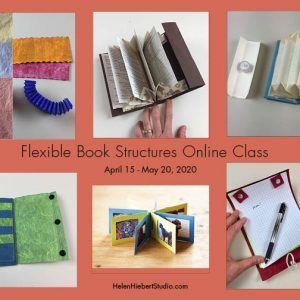
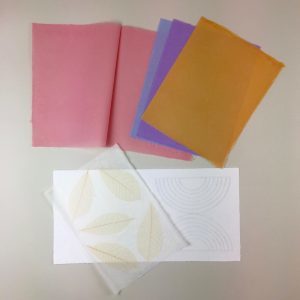
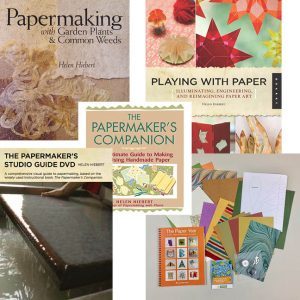
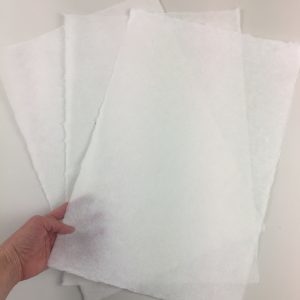
———————————————————————————————–––––––
If you read this blog regularly, would you consider making a donation to support the research, writing, design and delivery of The Sunday Paper? Click on the paper button at the left to learn how. Or, perhaps you’re interested in promoting your business in The Sunday Paper.
Thanks to everyone who has already pledged your support!
SHARE THIS blog post with your paper-loving friends!
March 21, 2020
Paper Pastries
The Sunday Paper #304
March 22, 2020
Paper of the Week: Abaca Leather + Thick Abaca

Can you see the difference between these two abaca sheets? It appears subtle in these photos, but they are quite different. Limited quantities of these abaca leather and thick abaca sheets are available on my website in The Paper Shop.
———————————————————————————————–––––––
In the Studio:
I’ve started shooting the videos and photos for the pdf instruction sheets for my upcoming online class Flexible Book Structures. I also ordered all of the supplies for the kits, which will begin shipping on April 1st. I ordered a few extra sets, so you can still join us! You can also sign up and source your own supplies. I am thankful to be able to get to my studio and to have a great group of participants signed up for the course, which begins on April 15th!
———————————————————————————————–––––––
Papery Tidbits:
Need a project for the kiddos (or yourself)? Here’s a Spring Shamrock video tutorial, which could double as a snowflake (it is still snowing here in Colorado). This can be made from any paper. Send me a photo if you try it!
I enjoyed this newsletter by Andrew Simonet: Artists, this is what we train for… it reminded me that I have a lot of the assets that can be utilized in trying times.
It was so lovely to get notes from my newsletter readers this week, responding to my note about living in the moment, the passing of my father-in-law and the title of the newsletter (Cutting Across the Fold). For those who are curious, that title was quite literal – referring to the way you cut across folded papers to create a shamrock or snowflake design. Try it!
———————————————————————————————–––––––
This is a beautiful story about art and life. Morgana Wallace is uses paper cutting to make illustrations that bring us back to childhood.
I love this story about a teacher who has figured out a great project for her special needs kids, who are creating handmade cards to be sold at the school’s Paper Pastries card store.

Diego Cagara / Spotlight News
Ledger art takes its name from the source of the paper that Native Americans began to use as European settlement moved westward. As tribes came into possession of ledgers, ink and pens, their artists expanded their craft, which had primarily consisted of using bone fragments and earth pigments to paint on shields and robes. Joe Pulliam is carrying on this tradition.

Artist Joe Pulliam continues the custom of his ancestors as he creates art on used ledger pages.
Olivia Fraser has lived and worked in India for many years, studying yoga and miniature painting. Her recent work uses traditional, handmade materials all sourced locally and in their natural forms in the markets in Jaipur.
This is a great video by a young woman who is doing amazing things with origami + math + fashion. She explains what she is doing so well!
———————————————————————————————–––––––
The News from Here:
Colorado doesn’t have shelter in place orders yet, although we have a lot of COVID-19 cases and a small hospital, so I am basically staying home and going to the studio, where I work alone. I go out for walks with my dog Halo and a couple of friends in the neighborhood. My husband returns tomorrow from laying his father to rest and helping his mother prepare for living on her own in the south Chicago suburbs. I have been sharing stories with friends from around the world – we are fortunate to be able to keep in touch!
My life hasn’t changed drastically, as I know it has for others. I live in a ski town, and all of the seasonal workers lost their jobs this week, in addition to the restaurants and bars closing. But we humans are adaptable and inventive, and I am seeing signs of hope and love. The newspaper ran a full-spread about all of the restaurants and what they are offering in terms of take-out, and the libraries will get your books and deliver them to you in your car. They are also hosting story time for the kiddos online (I love libraries). These are just two small examples of keeping hope alive as we meander through these uncertain times.
I have started a different morning routine: sleep in (or fake it so my dog thinks I’m sleeping) til the sun comes up at 7am (I used to go to the gym at 6am); take the dog for a walk, come home and do 30 minutes of yoga (someone in my neighborhood turned me on to this App), clean for 30 minutes (this is a new thing, and I hope to keep it up). Make breakfast and coffee and then get to work!
I am so thankful to all of you in my virtual community! I am thinking about you. Please take care of yourself and help out where you can!
———————————————————————————————–––––––
Featured this week in my Studio shop:
Flexible Book Structures online class, Abaca Leather, The Paper Lovers Package, and Thick Abaca Sheets.
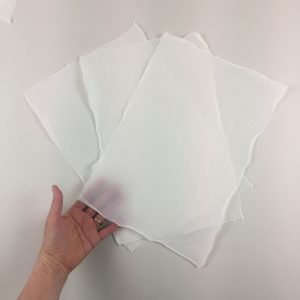


———————————————————————————————–––––––
If you read this blog regularly, would you consider making a donation to support the research, writing, design and delivery of The Sunday Paper? Click on the paper button at the left to learn how. Or, perhaps you’re interested in promoting your business in The Sunday Paper.
Thanks to everyone who has already pledged your support!
SHARE THIS blog post with your paper-loving friends!
March 14, 2020
Making & Baking
The Sunday Paper #303
This issue of The Sunday Paper is dedicated to my sweet father-in-law, Pete, who passed away this week at the age of 92.
March 15, 2020
Paper of the Week: Dare I mention TP?
My husband fell in love with Japanese toilets last fall and decided to get me one for Christmas. I wasn’t so sure what I thought of this gift at first, but it might come in handy now that I’ve been to two stores that were completely out of TP!
Here’s a preview of next month’s project in The Paper Year – Plantable Paper. This might be a fun project for your kids who are home from school for spring break and beyond due to COVID-19. All you need are 6 squares of TP (although once the kids make a sheet, they’ll probably want to make more). Embed seeds in your paper, plant it, and watch it grow.
I showed some neighborhood girls how to make plantable paper last fall. They show you how you can make plantable paper in this adorable video.
———————————————————————————————–––––––
In the Studio:
An artist friend came up to the studio with me on Friday, and we made this pop-up card that Jean-Paul LeConte generously shared over in The Paper Studio (scroll down on that page to find the Butterfly Pop-Up Card Tutorial). I’m sending this one to my mother-in-law in Indiana. Listen to my interview with Jean-Paul LeConte on Paper Talk – he creates a weekly pop-up to explore and perfect his paper engineering skills, and he and his girlfriend run the popular website BestPopUpBooks.com.

———————————————————————————————–––––––
Papery Tidbits:
Have you listened to this episode of Paper Talk featuring Robbin Silverberg?
Visit The Paper Library to find places to shop for paper, take workshops, some free paper video tutorials and a selection of how-to books about paper.
———————————————————————————————–––––––
Check this out: lack of funding bars production of this handheld paper device developed by biomedical engineers at Purdue University to test for COVID-19. I’ve heard of other tests being developed – and hopefully they’ll get where they need to soon! It turns out that lots of tests are paper based. ‘Tis a wonder material!
I’m a super fan of material-based artwork, and this exhibition in Chicago looks amazing. The Allure of Matter: Material Art from China encompasses 48 works from 26 contemporary Chinese artists. And this work by Shi Hui features handmade paper!

Shi Hui, “Float” (2000/2007/2013), wire mesh and xuan paper pulp. Installation view at China Academy of Art, Hangzhou
Don’t forget! If you are thinking of registering for Flexible Book Structures, the cut-off for ordering the supply kit is Weds, March 18th (AND you get a free copy of The Paper Year if you order the kit by that date). Join us and create a set of unique book structures in your own space at your own pace. Watch the video, learn more and register today!
I love reading the All Things Paper newsletter and blog. Ann Martin has some lovely sentiments about beautiful images creating a sense of well-being, especially today. Take a peek.

Paper flowers by artist Kate Alarcon
Things are unsettling these days as we see what is happening around the world and in our own communities due to COVID-19. Both of my children are in the Chicago area in college: one of their schools is going online for the rest of the year; the other has an extended spring break. My mother lives in an assisted facility near me, but I am not allowed to visit.
What do you do in times like these? I try to stick to routines (like going to yoga, walking and swimming), and I continue to do things that make me happy: like making and baking. I have been baking these pumpkin muffins for several weeks now (this time I substituted coconut sugar, used coconut milk and because I live at altitude, I like to use 1 cup of white flour/the rest whole wheat). I also enjoy knitting (although I’m having a hard time finding a project at the moment), as well as creating my own art. My book deadline is in three weeks! Recent events are making it harder to concentrate, but I intend to be done with the manuscript by then, and some of the samples and steps for photography will be completed later, for the photo session next fall.
Since I work for myself, I don’t have to change my work habits, but I do have to worry about lost income – it looks like a teaching gig in April will be postponed for a year. Fingers crossed that events this summer in the studio will still go on.
I am so thankful to all of you in my virtual community! Please take care of yourself and help out where you can! I’ve seen The Quarantini (martini by yourself) mentioned a couple of times, and Pandemic Papermaking – one professor’s new class title for her hand papermaking that now has to meet online. Art and humor will tide us over. And, as my yoga instructor said this morning, we will weather the storm, as we always do.
———————————————————————————————–––––––
Featured this week in my Studio shop:
Flexible Book Structures online class, Alpha Beta, an alphabet book, The Paper Lovers Package, and Grid Paper.
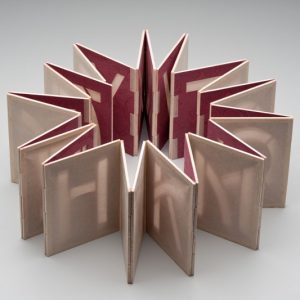

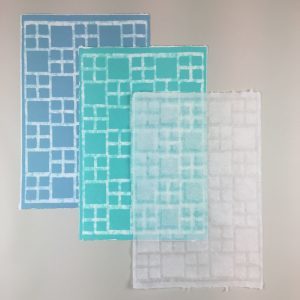
———————————————————————————————–––––––
If you read this blog regularly, would you consider making a donation to support the research, writing, design and delivery of The Sunday Paper? Click on the paper button at the left to learn how. Or, perhaps you’re interested in promoting your business in The Sunday Paper.
Thanks to everyone who has already pledged your support!
SHARE THIS blog post with your paper-loving friends!
March 7, 2020
Read Me Like A Book
The Sunday Paper #302
March 8, 2020
Paper of the Week: Flexible Book Structures + Paper Kit
We are going to be exploring a variety of unique papers in my upcoming online class, Flexible Book Structures. We’ll apply konnyaku to Korean hanji to make momigami, stain Tyvek, create a book light with hanji and Japanese linen, a scroll with a leathery paper called Kraft Tex and more. Click here to watch the video trailer and read all about it. I’m hosting a free webinar on Thursday, March 12th if you’d like to learn more, or you can sign up today. There’s a bonus! If you register by March 18th and purchase the kit, I’ll send you a complimentary copy of The Paper Year.
———————————————————————————————–––––––
In the Studio:
I’m finishing up a paper quilt that I will be exhibiting in a group show that an IAPMA (International Association of Papermakers and Paper Artists) member is coordinating in Santa Fe. I am planning to attend the opening of A Conversation with Paper at Gallery Fritz on April 24th. I hope to see some of you there!
———————————————————————————————–––––––
Papery Tidbits:
Sets of all of four Twelve Months of Paper Calendars + The Paper Year are available at a big discount. You can also get 1/2 price single copies of The Paper Year.
There is one spot left at the Red Cliff Paper Retreat. Will it be yours?
———————————————————————————————–––––––
Listen to my conversation with Robbin Ami Silverberg on Paper Talk! Robbin is a paper and book artist in Brooklyn, NY, whose content-rich artist’s books I have long admired. We had a lovely meandering conversation starting with the paper sculptures she made in college and ending up with an overview of her 30-year retrospective at Pratt Institute in Brooklyn – Read Me Like A Book– which is on view through April 9th. Fun fact: Robbin and I were on Sesame Street with a bunch of cute kids making paper in the mid-1990’s. Enjoy our conversation!
This is not paper, but I think you can see how it is inspired by origami. Issey Miyake does it again! Watch the video at this link – there’s a super clever reveal in the beginning when a giant paper screen is cut open.
Did anyone get a chance to see this at Art on Paper in NYC? It is still going on today!
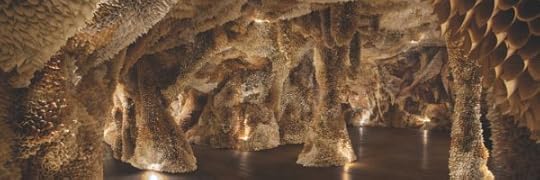
Samuelle Green | Manifestation 4
The birds are starting to chirp a bit more over here as we’re having a spring tease. Check out these amazing sculptures by the artist Lisa Lloyd. Lloyd constructs their feathers and wings with tiny pieces of scalloped paper, often using 4,000 paper pieces on a single model. And she studies their movements before capturing them in paper.
We have a new challenge over in The Paper Studio. We’re making Strip Books, the March project in “The Paper Year”. They’re a lot of fun to make and there are as many variations as you can possibly imagine. How many strips will you cut? What kind of paper will you use? What shape will your strips be? How will you connect them? There are so many possibilities! Click on over to find out more… I’m looking forward to seeing your creations!
———————————————————————————————–––––––
Featured this week in my Studio shop:
Flexible Book Structures online class, Water Paper Time, a paper meditation in the form of a film, The 12 Months of Paper Collection, and Grid Paper.
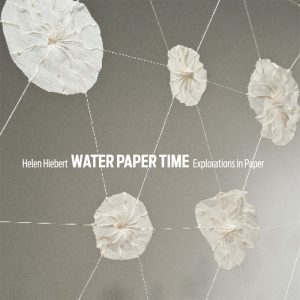
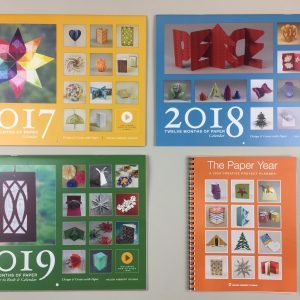

———————————————————————————————–––––––
If you read this blog regularly, would you consider making a donation to support the research, writing, design and delivery of The Sunday Paper? Click on the paper button at the left to learn how. Or, perhaps you’re interested in promoting your business in The Sunday Paper.
Thanks to everyone who has already pledged your support!
SHARE THIS blog post with your paper-loving friends!
February 29, 2020
Peace Postcards
The Sunday Paper #301
March 1, 2020
Paper of the Week:
I was focusing on abaca over on instagram this week, where I shared several works I’ve created over the years with this incredible, shrinking, sculptural material. Abaca is banana plant waste that I grind into a mushy malleable pulp and turn into sheets of paper which are smooth enough to draw on, supple enough to fold into book pages and strong enough to construct sculptures and installations. This is a mock shoji screen. I visited Japan early in my career and wondered why there weren’t any shoji screens with organic shapes. So I made one, and it was incredibly labor intensive (plaster wrapped wire screening, artist-made abaca with onion skin).
———————————————————————————————–––––––
In the Studio:
Registration for Flexible Book Structures officially opens tomorrow, but since I’ve got everything ready, you can sign up now! Please click through to watch my 3 minute video about the course, read all about it, and register! And feel free to spread the word to your paper and book loving friends.
———————————————————————————————–––––––
Papery Tidbits:
Sets of all of four Twelve Months of Paper Calendars + The Paper Year are available at a big discount (the calendars are out of date, but the instructions for 48+ projects last forever).
There is one spot left at the Red Cliff Paper Retreat. Will it be yours?
———————————————————————————————–––––––
Toyota, a staunch supporter of Woza Moya, tasked the women of the organization with producing 8 000 origami cats for an installation at launch of the new luxury Lexus at the Investec Art Fair 2020 in Cape Town. I couldn’t find an image of the cats at the fair which took place recently, but the idea behind the project is to show how much skill and dexterity is required to be a Takumi craftsman or artisan, one of the supremely skilled craftsmen who work on the exclusive Lexus. Here’s a bit of info about Woza Moya, which is behind the craftspeople who created the cats. It was founded in 2000 in direct response to the HIV/AIDS pandemic that was ravaging the Ufafa Valley Community in South Africa.
A Japanese papermaker has started making postcards from strings of origami cranes that were donated to the atomic bomb museum in Nagasaki Prefecture as symbols of peace. Having visited the memorial in Hiroshima just months ago (where I received a similar postcard with admission), I know how many cranes are donated, and this seems like a worthy venture to turn them into handmade sheets!

A postcard made from cranes from the Nagasaki Atomic Bomb Museum is seen embossed with a smiley face. (Mainichi/Mio Ikeda)
Check out this amazing paper cut art by Antonius-Tín. Click on the image, and you’ll be taken on a gallery tour through their exhibition, ‘finding heart’.
This is a fascinating story about a limited edition book featuring handmade paper covers (with mica)! Charnel House, longtime publisher of artfully designed limited editions in Catskill, New York, has released Ellison Under Glass, a collection of stories written mostly in bookstore windows.

© CHARNEL HOUSE
I love this story about a 4th/5th grade art teacher who won a grant for her proposal to create handmade paper art lessons to engage students in the harvest of cotton and flowers from the school’s garden. A teacher after my own heart (I developed and ran Papermaker’s Garden projects in NYC and Portland, OR).
———————————————————————————————–––––––
Featured this week in my Studio shop:
Flexible Book Structures online class, Water Paper Time, a paper meditation in the form of a film, The 12 Months of Paper Collection, and Grid Paper.



———————————————————————————————–––––––
If you read this blog regularly, would you consider making a donation to support the research, writing, design and delivery of The Sunday Paper? Click on the paper button at the left to learn how. Or, perhaps you’re interested in promoting your business in The Sunday Paper.
Thanks to everyone who has already pledged your support!
SHARE THIS blog post with your paper-loving friends!
February 22, 2020
Water Paper Time
The Sunday Paper #300
February 23, 2020
Paper of the Week: Tant Origami Paper
Two contributors to the book I’m writing recommended Tant origami paper, which I’d never heard of before. But you know how when you hear about something, it starts appearing everywhere? I was talking to a paper distributor a few weeks ago who told me that Tant is packaged in Echizen, the paper town I visited in Japan. Well of course, I had to get some to see for myself (and of course, to re-create the projects that are being contributed to my book). I got a pack of 100 sheets (6″ x 6″) in assorted colors. I created the weaving you see here during Weave Through Winter (my online class that wrapped up last week). Oh, and that little 300 in the middle is because this is the 300th edition of The Sunday Paper! I wonder if anyone has read all 300 issues?
———————————————————————————————–––––––
In the Studio:
I am busy creating the prototypes for the projects in my upcoming online class Flexible Book Structures. This is an expanding file folder book with a magnetic closure.
———————————————————————————————–––––––
Papery Tidbits:
Sets of all of four Twelve Months of Paper Calendars + The Paper Year are available at a big discount (the calendars are out of date, but the instructions for 48+ projects lasts forever).
Registration for my spring online class Flexible Book Structures II opens in early March (that’s soon)! Sign the list to receive a $10 coupon when registration opens.
Have you listened to my interview with origami master Michael LaFosse on Paper Talk?
———————————————————————————————–––––––
I love the simplicity of pure white paper. Angela Glajcar creates environments using just hand-torn paper, light, and space. Her work is on view through March 28th at K.OSS Contemporary Art in Detroit.

Courtesy of K.OSS Contemporary Art
More white! Ayumi Shibata envisions the three-dimensional shapes she wants to create and begins cutting. I love what she says: “White paper expresses the yang, light, and the process to cut expresses the yin, shadow. When the sun shines upon an object, a shadow is born.”
The Press at the Palace of the Governors has a new limited edition publication: Narrative of the Life of Frederick Douglass An American Slave. 2020 marks the 175th anniversary of the first appearance of this text. I enjoyed reading about the paper used for the book: the text is printed on Zerkall Book, a mould-made paper from the Zerkall Paper Mills near Düren, Germany, and Barry Moser’s engravings are printed on a vintage mould-made sheet from the Whatman Paper Mills near Maidstone, England, founded in 1740. The marbled papers were made by the book’s printer, Thomas Leech. Only sixty copies are available. Ooh la la!
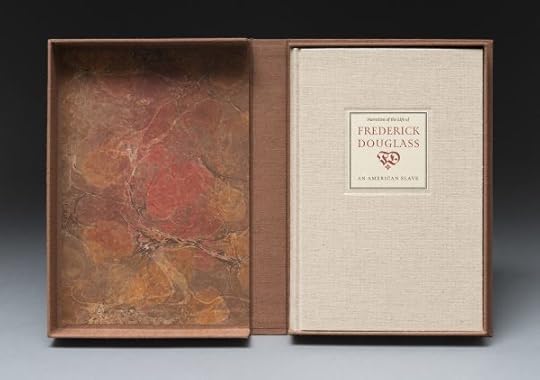
Courtesy of Press at the Palace of the Governors, photo Margot Geist
Look at this gorgeous tunnel book that Lisa Merkin shared over in The Paper Studio. We’re focusing on pop-ups this month, and it has been amazing to see all of the variations. Interested in creating with us on Facebook? You’ll find us in The Paper Studio. Simply request to join the group and we’ll see you there!
This is a cool video about John Collins, who flies world record paper airplanes.
———————————————————————————————–––––––
Featured this week in my Studio shop:
Tangential, Water Paper Time, a paper meditation in the form of a film, The 12 Months of Paper Collection, and The Papermaker’s Companion.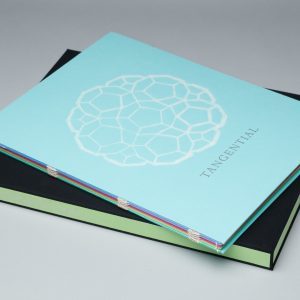


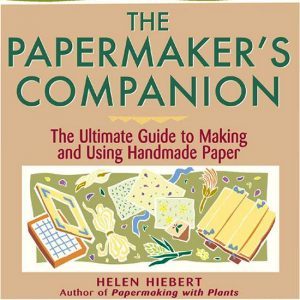
———————————————————————————————–––––––
If you read this blog regularly, would you consider making a donation to support the research, writing, design and delivery of The Sunday Paper? Click on the paper button at the left to learn how. Or, perhaps you’re interested in promoting your business in The Sunday Paper.
Thanks to everyone who has already pledged your support!
SHARE THIS blog post with your paper-loving friends!
February 15, 2020
Papermaking in Action
The Sunday Paper #299
February 16, 2020
Paper of the Week: A Sheet of Abaca in 1:20
I made a short video of me making a sheet of abaca. The sheet size is 18″ x 23″ and I’m making it on an old English mould that I purchased at Wookey Hole Mill many years ago (that was a trip – walking into a room filled with hundreds of old moulds & deckles). It only takes about 1-1/2 minutes to pull and couch a sheet (I cut out the time it took that abaca to drain), but there’s so much more to making paper!
———————————————————————————————–––––––
In the Studio:
 I am in the home stretch of writing my book about the versatility of paper and the objects that can be created from a single sheet. I go through alternating waves of I’ve got this! and There’s no way I can do this! One way or another though, this book will come to be, and I have to say that I will be so happy when I turn in the manuscript in early April. The book is slated to come out in 2021. Here’s a sneak peek of just a few of the projects that will be featured in the book.
I am in the home stretch of writing my book about the versatility of paper and the objects that can be created from a single sheet. I go through alternating waves of I’ve got this! and There’s no way I can do this! One way or another though, this book will come to be, and I have to say that I will be so happy when I turn in the manuscript in early April. The book is slated to come out in 2021. Here’s a sneak peek of just a few of the projects that will be featured in the book.
———————————————————————————————–––––––
Papery Tidbits:
There are two spots left in the 7th Annual Red Cliff Paper Retreat (Aug 29 – Sept 2, 2020). This year’s theme is Woven Paper: Books/Vessels/Lighting.
Sets of all of four Twelve Months of Paper Calendars + The Paper Year are available at a big discount (the calendars are out of date, but the instructions for 60+ projects lasts forever).
Registration for my spring online class Flexible Book Structures 2 opens in early March. Sign the list to receive a $10 coupon when registration opens.
———————————————————————————————–––––––
I had a fun conversation with origami master Michael LaFosse on Paper Talk. Michael runs Origamido studio outside of Boston, a unique studio, where he not only creates, folds and teaches unique origami techniques, but they also produce handmade papers designed specifically for folding and origami. Enjoy our conversation!
Artist Joanne B. Karr does the most interesting paper projects! Her recent project involved pairing up a heritage center and museums in Caithness and Sutherland, Scotland with organizations in Newfoundland by exchanging paper airplanes. This was to commemorate a failed trans-Atlantic flight in 1919 that Joanne read about, which linked these two places in the first place.
This is a great story about a young woman who is finding her way with paper and fiber. Nevada Tribble’s bicycle-powered sewing machine allows her to do her sewn life drawings outside – how cool is that?!
 May You Live in Interesting Times, an exhibition of artist’s books, is currently on display (through April 18) at the Northern Arizona University Art Museum. The writer seemed surprised to encounter books as art, but I’m hoping this will become the norm one of these days! I was happy to discover this piece by Karen Baldner, who gave me a lovely tour of the classroom where she teaches paper and book arts at IUPUI in Indianapolis this past summer.
May You Live in Interesting Times, an exhibition of artist’s books, is currently on display (through April 18) at the Northern Arizona University Art Museum. The writer seemed surprised to encounter books as art, but I’m hoping this will become the norm one of these days! I was happy to discover this piece by Karen Baldner, who gave me a lovely tour of the classroom where she teaches paper and book arts at IUPUI in Indianapolis this past summer.
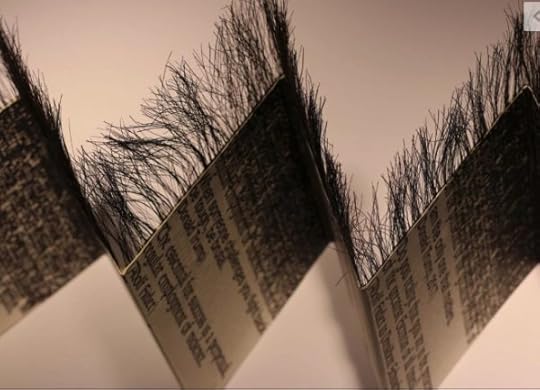
© Karen Baldner, Raising Hackles
The writer of the article I just referred to used the words visual storytelling in the title of his piece. And then I discovered paper cutter extraordinaire Béatrice Coron’s recent Ted Talk about visual literacy. Béatrice and I are making plans to co-teach a workshop in the near future.
———————————————————————————————–––––––
Featured this week in my Studio shop:
Tangential, Mend, The 12 Months of Paper Collection, and The Papermaker’s Companion.
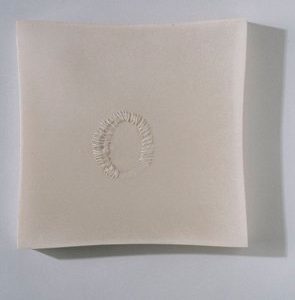


———————————————————————————————–––––––
If you read this blog regularly, would you consider making a donation to support the research, writing, design and delivery of The Sunday Paper? Click on the paper button at the left to learn how. Or, perhaps you’re interested in promoting your business in The Sunday Paper.
Thanks to everyone who has already pledged your support!
SHARE THIS blog post with your paper-loving friends!
February 8, 2020
A Pop-Up Valentine for You
The Sunday Paper #298
February 9, 2020
Paper of the Week: Weave Through Winter
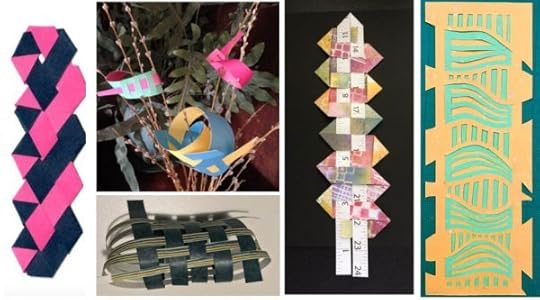
Top left moving clockwise: Andrea Martin, Ann Kebbell, Suzanne Berland, Cynthia Reid, Susan Ruptash.
We are finishing up our 30 Days of Weave Through Winter on Valentine’s Day, and it has been such a treat to see the variety of weavings that have been created over the past few weeks, not to mention the papers! This week there was a challenge to weave just two strips of paper, and it was amazing to see the variety of weavings that came out of that. These are just a few of them! Check out the hashtags #weavethroughwinter or #weavingthroughwinter to see many more paper weavings.
———————————————————————————————–––––––
In the Studio: Skiing + Papermaking
George Freitag has paired a couple of days of papermaking with a ski trip to Vail twice over the past couple of years. This time we processed pre-cooked Thai kozo in the beater and mixed it with bulrush he brought with him from Canada (he almost missed his flight due to declaring the plant fiber). He’s making rack cards for his hotel and I showed him how to cover panel lampshades. Fun!
———————————————————————————————–––––––
Papery Tidbits:
Registration is now open and you are invited to my studio in Colorado’s Rocky Mountains for the 7th Annual Red Cliff Paper Retreat! The 2020 Retreat theme is Woven Paper: Books/Vessels/Lighting.
The Paper Year is still available, now at a discount.
I am developing new projects for my spring online class Flexible Book Structures 2 . Sign the waiting list to receive a $10 coupon when registration opens in early March.
———————————————————————————————–––––––
Do you still make Valentines? Here’s one that you can download and print on any paper. Better yet, share your photo in The Paper Studio. Have a Happy Valentine’s Day!
This is a unique tribute to Kobe Bryant by Jake Van Yahres at the Randolph Community Center’s basketball court in Richmond, Virginia. I think those are crumpled paper balls.
Seed paper has taken many forms over the past couple of decades. Here’s a company in Bangladesh that is making a paper that can be recycled by planting it.
There were lots of intriguing works on and of paper at the Outsider Art Fair in NYC last month. Check out this pop up painting by Itsuo Kobayashi. The paintings are pages from illustrated pop-up books, and the artist is a former restaurant worker who meticulously documents every meal he consumes.

Itsuo Kobayashi, Untitled (Pop-up Paintings) (2018-19), ink on paper, each piece 9 x 13 x 5 inches (photo courtesy of Kushino Terrace, Fukuyama, Japan)
This is a fun story about a dad who has his children draw him while he poses/aka takes a nap. I can remember that exhaustion from when my kiddos were little. Clever!
———————————————————————————————–––––––
Featured this week in my Studio shop:
Prism, Mend, The Paper Year, and The Papermaker’s Studio Guide.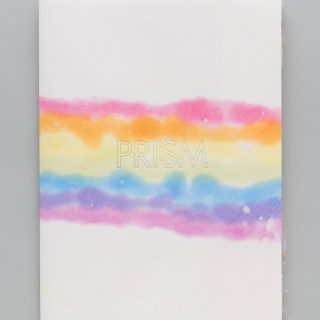

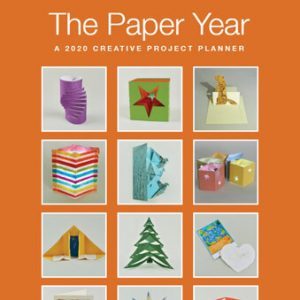

———————————————————————————————–––––––
If you read this blog regularly, would you consider making a donation to support the research, writing, design and delivery of The Sunday Paper? Click on the paper button at the left to learn how. Or, perhaps you’re interested in promoting your business in The Sunday Paper.
Thanks to everyone who has already pledged your support!
SHARE THIS blog post with your paper-loving friends!
February 1, 2020
Pop-Up Paper Groundhog
The Sunday Paper #297
February 2, 2020
Paper of the Week: Kyoseishi from Washi Arts
Kyoseishi (kee-o-say-shi) is a handmade, dyed Japanese paper than has konnyaku starch kneaded into the kozo fibers to strengthen the paper. Kyoseishi means strong paper. This type of paper is known as momigami (crinkled paper). The distinctive texture comes from the process of kneading the starch into the paper. This traditional technique was used to treat washi (Japanese paper) for use in clothing. This treated paper can be sewn and is wonderful for bookcovers, boxes, cases, jewelry, paper quilts and sculptural forms.
For readers of The Sunday paper, Washi Arts has put together a special package of eight half sheets (each is 18″ x 25″) Regular price is $62.00, sale price is $50.00.
———————————————————————————————–––––––
In the Studio: A Pop-Up Groundhog
We’re doing a monthly challenge over in The Paper Studio (TPS) on Facebook. The guest designer this month is Marianne Petit, an artist and educator who creates mechanical books that combine animation and papercraft. For the February project in The Paper Year, Marianne created a pop-up groundhog – because, after all, a groundhog DOES pop up! The question is, will the little critter see his shadow before he pops back down? If he does, legend has it that we’ll have 6 more weeks of winter.
For those of you who own The Paper Year, have fun creating your groundhog and please share it over in TPS. And for those who don’t have a copy, a pop-up valentine would be an interesting project. You can find a free downloadable PDF template/instruction sheet in the files area (in TPS) for a simple engineered valentine. Either way, let’s play with pop-ups this month! And it’s a leap year, so we even have an extra day popping up at the end. Feel free to explore, make and post a photo of whatever pop-up pops up in your creative mind :).
———————————————————————————————–––––––
Papery Tidbits:
Speaking of Playing with Pop-Ups – that’s the title of one of my books, which contains 15 projects by renowned paper engineers from around the world.
Registration is now open and you are invited to my studio in Colorado’s Rocky Mountains for the 7th Annual Red Cliff Paper Retreat! The 2020 Retreat theme is Woven Paper: Books/Vessels/Lighting.
The Paper Year is still available, now at a discount.
I am developing new projects for my spring online class Flexible Book Structures 2 . Sign the waiting list to receive a $10 coupon when registration opens in early March.
———————————————————————————————–––––––
Check out this music video featuring a paper animal animation by Seen Film, Vitamin String Quartet.
These gorgeous kiri-e (“kiri” means cut, and “e” means picture/art) works by Andrew Imamura were recently on display in Honolulu. Learn more about his work in this Q&A.

© ANDREW IMAMURA
SoulBoxes was recently in Denver showcasing one thousand origami boxes covering a wall at First Baptist Church of Denver. Each one is a different story of someone affected by gunfire in the United States. Watch the video about the project.
This paper food by ji-hee-lee probably doesn’t taste so good, but it is delicious eye candy!

© ji hee lee
“Pinyapel” is a Pinoy paper product made from discarded pineapple leaves in The Philippines. Recently, it won the D&AD Future Impact Awards for Environment and Sustainability in New York City. How cool is that?!
——————————————————————————————–––––––
About our Sponsor: Washi Arts is a merchant of fine Japanese paper, tools and supplies. We carry an extensive range of decorative, dyed and natural papers as well as brushes, adhesives and book arts tools. Contact us for recommendations for your projects and to join our mailing list.
———————————————————————————————–––––––
Featured this week in my Studio shop:
Word Broadsides, a selection of grid papers, The Paper Year, and Playing With Pop-Ups.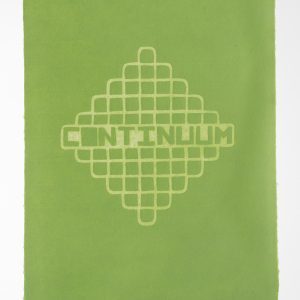


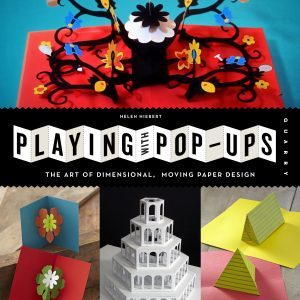
———————————————————————————————–––––––
If you read this blog regularly, would you consider making a donation to support the research, writing, design and delivery of The Sunday Paper? Click on the paper button at the left to learn how. Or, perhaps you’re interested in promoting your business in The Sunday Paper.
Thanks to everyone who has already pledged your support!
SHARE THIS blog post with your paper-loving friends!
January 25, 2020
A Cubicard Finale
The Sunday Paper #296
January 26, 2020
Paper of the Week: Jean-Paul LeConte on Paper Talk
It was such a treat to speak with Jean-Paul LeConte who runs the popular website Best Pop Up Books with his girlfriend Denice in The Netherlands. We talk about how the purchase of a copy of Robert Sabuda’s Alice in Wonderland pop-up book several years ago, led him down the paper engineering rabbit hole. He and Denice realized that people needed to see how pop-up books move in order to make a purchase online, so they started creating videos and posting them on Youtube, filling a niche and creating a community for those who love paper engineering and pop-ups. Enjoy our conversation!
Did you know that you can subscribe to Paper Talk on Itunes? Listen to the 50+ paper interviews I’ve done over the past few years, and be the first to find out about upcoming interviews with origami master Michael LaFosse, paper pioneer Douglass Howell’s daughter, and Pam Thorne, a paper artist in Tasmania.
———————————————————————————————–––––––
In the Studio: Paper Weaving
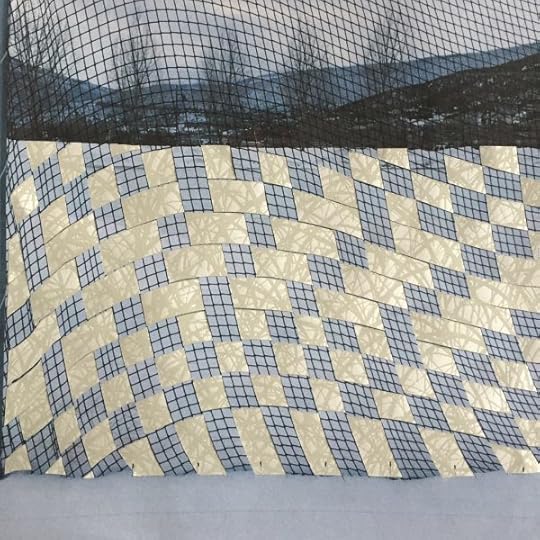
I have joined the participants in my Weave Through Winter online class in creating a daily weaving for 30 days. It is challenging and rewarding in so many ways! Here’s my Day 9 weaving, which I’m calling Blanket of Snow.
———————————————————————————————–––––––
Papery Tidbits:
Registration is now open and you are invited to my studio in Colorado’s Rocky Mountains for the 7th Annual Red Cliff Paper Retreat! The 2020 Retreat theme is Woven Paper: Books/Vessels/Lighting.
The Paper Year is still available, now at a discount. I have just four more paper kits in stock + plenty copies of The Paper Year if you have your own paper stash.
We are sharing our projects from The Paper Year over in The Paper Studio, my free Facebook group. You can join the fun, even if you don’t have a copy of The Paper Year!
———————————————————————————————–––––––
Rachel Hazell’s BookLove e-course attracts people from around the world to join the BookLove online community for two weeks of focused bookbinding. Freelance illustrator, Ceri Amphlett, outlines the impact that it has had on her work: ‘The flexibility to access and follow the course at my own pace from home was perfect. I enjoyed immersing myself in each of the projects, keeping a pace, sharing what I’d done and seeing what others had created and experienced. There was a real sense of community in the group, sharing our work and knowledge. All parts of the course felt lovingly designed and considered by Rachel from the written content to the tutorials and beautiful examples of her own work. There was plenty of guidance and inspiration as well as room to add your own thing. The writing exercises helped me realize how interested I am in words. Following the course, I brought together bits of my own writing and drawings and made an edition of hand bound books. The course has made a real impact on my working practice and still inspires me to explore my creativity.”
The next BookLove e-course starts on 24 February 2020. To sign up with a special 20% discount for readers of The Sunday Paper use the SUNDAYPAPER20 discount code.

© Ceri Amphlett: www.ceriamphlett.co.uk
Cubicards are popping up over in The Paper Studio! Here’s a lovely video created by Ruth Dailey, showing off her adaptation of the Cubicard design (special thanks to Lore Spivey). She’s sending these off as Valentine’s Day cards – what lucky recipients! If you’ve created the January project in The Paper Year, I hope you’ll post a photo in The Paper Studio. We’re wrapping up this project and will begin February’s project next week.
I love everything about this piece by Glen Baxter. I was really interested in the work of Kazimir Malevich (note the caption + look him up) early in my career. And this is ink and crayon on paper! Click through to see more of his witty work.

Glen Baxter, “‘And I’m Telling You, That’s A Dang-Blasted Malevich!’ Hollered The Curator” (2007), ink and crayon on paper, © Glen Baxter (all images courtesy of Flowers Gallery)
It isn’t every day that you see a book that’s illustrated with paper, in this case origami. Linda Stephen will launch her origami picture book, “The Day We Went to the Park,” Friday, Feb. 7 at Francie & Finch Bookshop in Lincoln, NE.
Live in Cleveland? This might be a reason to visit! The Cleveland Museum of Art is having an exhibition, Picasso and Paper, which opens Sunday, May 24: “Picasso’s relentless exploration of working on and with paper is featured in the many assembled collages of cut-and-pasted papers, sculptures from pieces of torn and burnt paper, documentary photographs and manipulated photographs on paper, and an array of printmaking techniques on paper supports,’’ the museum said in a news release.
———————————————————————————————–––––––
Featured this week in my Studio shop:
Word Broadsides, a selection of grid papers, The Paper Year, and Playing With Pop-Ups.



———————————————————————————————–––––––
If you read this blog regularly, would you consider making a donation to support the research, writing, design and delivery of The Sunday Paper? Click on the paper button at the left to learn how. Or, perhaps you’re interested in promoting your business in The Sunday Paper.
Thanks to everyone who has already pledged your support!
SHARE THIS blog post with your paper-loving friends!

